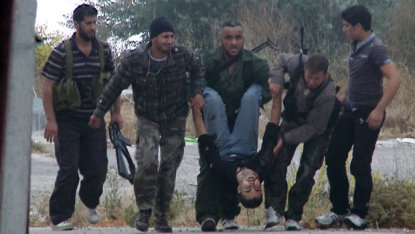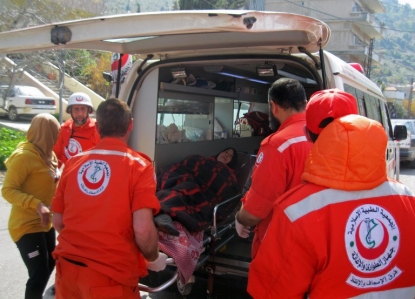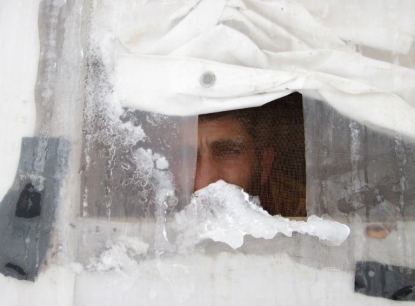Ties that bind, after the story ends
PARIS, January 28, 2015 - If you don’t have complete faith in someone who is taking you across a dangerous border - if you have even the slightest doubt - you don’t go. That level of trust between journalist and source creates a powerful bond. And a sense of duty if they later turn to you for help.
During my last mission in Syria, in June 2012, I crossed the border from north Lebanon to reach the crusader fortress of Krak des Chevaliers, a 1,000-year-old citadel captured by rebels at the start of the uprising against President Bashar Al-Assad.
If you get caught, you are dead.
My main contact on the trip was a young man named Ahmad. He is 24 years old, a student who took up arms for the Syrian rebellion because he didn’t have a choice. He wasn’t politicised at all to begin with.
 Syria's 12th-century Krak des Chevaliers castle and the adjacent village of al-Hosn (AFP Photo / Louai Beshara)
Syria's 12th-century Krak des Chevaliers castle and the adjacent village of al-Hosn (AFP Photo / Louai Beshara)Back then, AFP was one of the only media allowed to operate in Damascus. Assad had allowed the United Nations access to the besieged city of Homs, to win some relief from international pressure on his regime. We made the journey there with the UN.
The 'strong castle'
A young man came up to introduce himself. He told me the Syrian regime had arrested everyone with qualifications in his hometown of Azzara, the doctors, the engineers. A strategy well documented by rights groups. He also told me he travelled often to Beirut – where I was based at the time.
A week after I returned to the Lebanese capital, he called me. I asked him to help me organise a trip to Azzara, which lies at the foot of the Krak des Chevaliers, a rebel stronghold known in Arabic as Qalaat al-Hosn, or the “strong castle”.
[flvplayer flv=http://blogs.afp.com/english/public/V001_MMV435791_TEN_MP4_640X360.mp4; width=620; height=350; align=center; startimage=/english/public/.V001_MMV435791_TEN_JPEG_m.jpg; ] [/flvplayer]Back then the rebellion was made up of both Islamist and secular fighters. There was no talk of Islamic State (IS) jihadists, although it was here, in the region of Tal Kalakh, that Al-Qaeda later made its first incursion into Syria.
I spent three days and nights with Ahmad on what turned out to be an extremely dangerous mission, which I recounted in detail in an earlier blog post. During that time he saved my life.
I was filming when the brother of a fighter was shot in the head by a sniper. He was killed instantly. The guy was half-crazed with grief and when he saw my camera, he started pointing his machine gun at me, and reaching for ammunition to shoot. He really was about to kill me. It was Ahmad who managed to step in and reason with him.
 Syrian rebels carry the body of their slain comrade at Krak des Chevaliers in June 2012 (AFP / Djilali Belaid)
Syrian rebels carry the body of their slain comrade at Krak des Chevaliers in June 2012 (AFP / Djilali Belaid)A few weeks after I returned to Lebanon, I tracked him down via my contacts in the north – and he got in touch with me via Facebook and Skype.
Ahmad would send me news of his comrades-in-arms, who was in jail, who had been killed – complete with photos of their bodies, as is the custom in such circles. I would open my email in the morning and stumble on a corpse – not an easy experience.
Shot in the head
After some time we fell out of touch. Then one day I came across a picture, posted online by another contact, of Ahmad in a hospital bed in Lebanon.
I learned he had been gravely injured when the Krak des Chevaliers was recaptured by Assad’s forces. He was shot in the head and needed urgent surgery. For someone in his position to get that kind of care, you need strong contacts within the NGO community.
 A woman injured as regime forces seized the Krak des Chevaliers on March 20, 2014 (AFP Photo / Ghassan Sweidan)
A woman injured as regime forces seized the Krak des Chevaliers on March 20, 2014 (AFP Photo / Ghassan Sweidan)He asked me for help. I tried to put him in touch with Lebanese contacts of mine to have him treated in the local system. And then I put him in contact with an international NGO which is now working to obtain the reconstructive surgery he needs.
Many of the people I spent time with at the fortress were later injured or killed. For the dead, there is nothing more you can do. For the injured, you can offer material help or psychological support, by way of gratitude.
Ahmad is now in an area of north Lebanon called Akkar, where some local children go to school barefoot. It really is the poorest of the poor, and now it’s coping with a flood of Syrian refugees as well.
Far from home
It is a bit like corresponding with a prison inmate. They have been cut off from their loved ones, they are far from home, unwanted in Lebanon – a country of 4.5 million overwhelmed by an influx of well over a million desperate Syrians.
It’s a breath of air for them, just to maintain a conversation with a world that is at peace.
 Syrian refugees at a camp damaged by a storm in Akkar, north Lebanon on January 7, 2015 (AFP Photo / Ibrahim Chalhoub)
Syrian refugees at a camp damaged by a storm in Akkar, north Lebanon on January 7, 2015 (AFP Photo / Ibrahim Chalhoub)I covered all of the Arab spring uprisings and I’ve remained in touch with a lot of people. It’s part of the job to follow through on stories like this, sometimes for a long time.
On the other hand if you had to ‘pay back’ everyone whose path you cross, everyone who helps you in this profession, you would never see the end of it.
A kind of therapy
Apart from Ahmad there are four people met on assignment with whom I have stayed in sustained contact – and who I try to help. I cannot say more about them, for fear of putting their safety at risk. But all of them are very dignified people. And none has ever asked me for anything unreasonable.
 A Syrian refugee looks out of his tent in Lebanon's Bekaa valley, on January 7, 2015 (AFP Photo / Wissam Al-Omor)
A Syrian refugee looks out of his tent in Lebanon's Bekaa valley, on January 7, 2015 (AFP Photo / Wissam Al-Omor)You grow attached to people like that. Students suddenly thrown into war. Innocents who offer you help without asking anything in return. You find yourself morally tied to them. And a little bit trapped.
But in truth, it’s also a kind of therapy for journalists.
The Krak des Chevaliers mission was more than two years ago. But it still haunts me in my sleep. Like anyone who has been on this kind of assignment, we have all had the nightmares… Ahmad is the contact with whom I have kept the strongest bond. I don’t know if it amounts to friendship. But we have a lot of shared baggage.
We came close to dying. It takes time to get over that. It’s important not to cut the connection. Staying in touch helps to turn the page, for both sides. As a way of saying that life goes on, both here and there.
Djilali Belaid is an AFP video journalist based in Paris. He was AFP video coordinator for the Middle East and North Africa based in Beirut from 2008 to 2012. His report from Krak des Chevaliers won 2nd prize in the television trophy at the 2013 Bayeux-Calvados war correspondents' awards. Some names have been changed for the purpose of this report.


